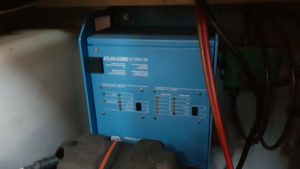So we have been experiencing strange smells which we have assumed was an odour from the waste holding tank. I have been flushing out the tank and treating with an odour reducing product, but the smell just wont go away.
Having flushed out the tank were went on a short passage across the bay to a favourite anchorage and the smell got worse on the passage. This was most stage as the smell dissipated upon reaching out anchorage, although I had opened various windows and didn’t think to much of it.
When we returned from our trip, and hooked up to the mains power on our birth, I was carrying out the usual shut down checks. When I noticed the older of the house batteries gassing like mad. This can be a dangerous situation not only from the fumes but the fumes are very flammable. The battery was just boiling away.

The older battery which has been gassing
After letting the battery cool down, I decided the best thing to do was remove the older battery and just have the newer house battery which is less than a year old.
I figured that the older battery had just reached the end of its life span. However the voltages which was showing had been giving me some concern, as the battery voltages have been a little low to the point that the fridge has been cutting out probably due to a low voltage and the gas alarm has been setting off due to low voltage not only when off charge but also when on charge which seemed a little strange. I had not experienced this before.
Checking the charger manual, when the charger is first connected to shore power the volts are supposed to boost at 14.2 volts with a 50 amp current. As the battery charges the amps are supposed to fall to a trickle. However with our charger the boost voltage is 14.9 and the amps does reduce down to a trickle but stays at 14.9 volts for about four hours. It is not good for a battery to be subjected to such a high voltage for such a long period of time.

The newer battery
After the boost period, the ‘float’ voltage when on charge is supposed to be 13.5 volts with the amps dropping to a trickle when the battery is fully charged. However the float voltage was only 12.5 volts which means even when on charge any demand on the system such as lights or a fridge will drain the battery as there is no input from the charger. A battery allowed to discharge below 50% charge could be damaged.

The Combi Charger/Inverter
So it has been out with the screw driver to adjust the float and boost voltage to the correct levels.
Having the newer battery of less than a year old, on charge for a period of time the single house battery was tested. When off charge the battery held an at rest voltage of 12.5 volts which on its own was sufficient to run the fridge. However when the battery was put under further stress such as turning on a few lights and the water pump, the volts dropped to about 12.35 volts, which meant that the fridge stopped working. The battery seemed to struggle with providing a stable power supply after a short period of time.
I guess that it is not surprising that batteries will be damaged if cooked with 14.9 volts and drained to a low charge even when on charge. So a pair of new deep cycle batteries are on the menu of things to do in the immediate future.
The big question however is how did the volts get out of alignment in the first place. Was it factory set up? Was it not set up properly originally? Was it changed by a previous owner? Or does the voltage set up just wonder off over the passage of time?
Maybe, I will just never know……
On passage back from our favourite anchorage.
Next time….finding a location for the life raft. Not as easy as you would imagine…
Short cut to my ShutterStock Portfolio – https://goo.gl/5Mvedj

